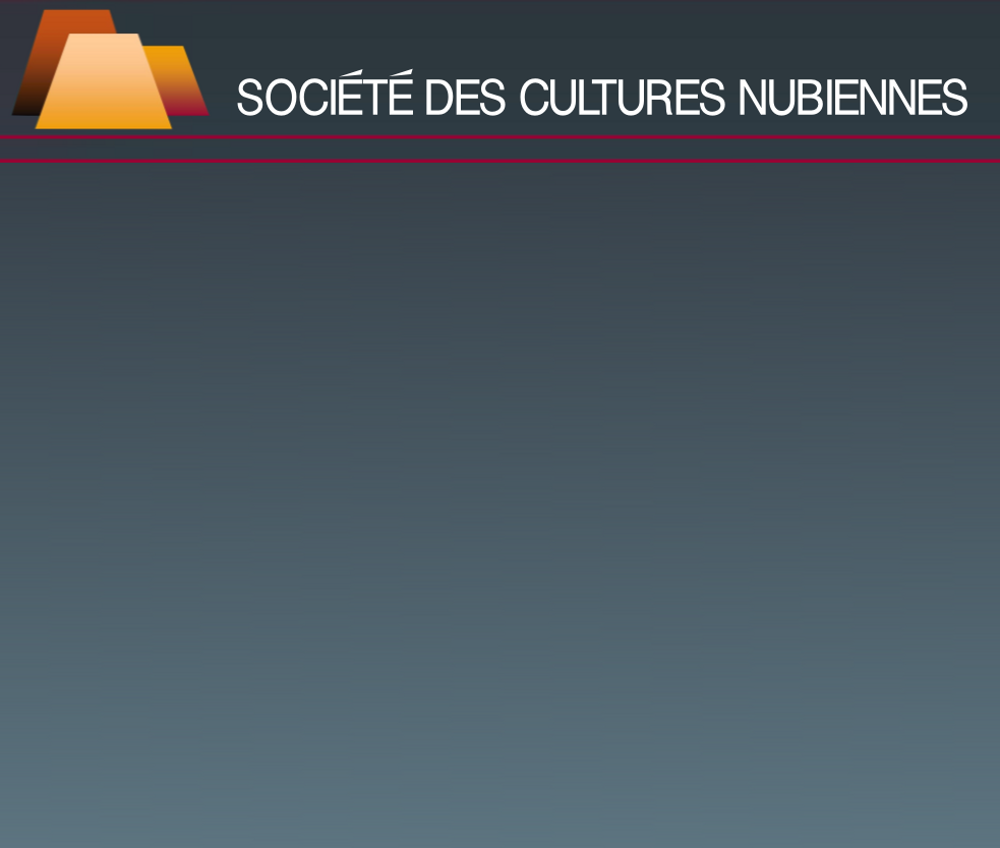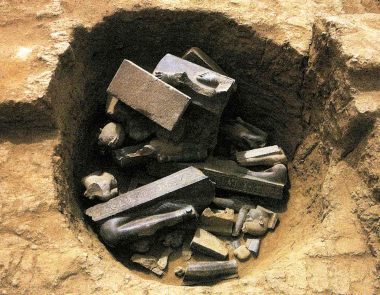


|
DUKKI GEL
It is thus that in 2003 there is a further discovery in this area, a cachette (subterranean deposit for votive offerings) measuring three metres in diameter. It contains 50 fragments of granite, the remains of seven statues dedicated to the last sovereigns of the XXV Dynasty at the beginning of the Napatan period (690-590 BC). From Taharqo to Tanwetamani, from Senkamanisken to the kings Anlamani and Aspelta, the craftsmanship is remarkable: the polish of the granite, the pecking of the garments and of the hair allowing for a better adherence of the pigments and the cloth, which was covered by a fine layer of gold-leaf covered plaster. Other fragments dated to the New Kingdom make up the cachette treasure (a falcon head, a king or prince's head, a female statuette, a seated statue of a cavalry commander). The Napatan period statuary confirms an Egyptian influence but equally a local style that imposes itself until the end of the Meroitic Kingdom. The characteristics are a powerful body and a face with Nubian traits.
The analysis of the fragments reveals that the statues were intentionally broken at the level of the neck, the arms, the legs and the feet. Why? We know that an expedition commanded by the Egyptian sovereign Psammeticus II in 591 BC was launched against the 'Land of Pnubs', a toponym of the Kerma area. Could it be as a consequence of this expedition that the statues were broken and then placed together in the cachette? |
 Fragments of statues of the last kings of the XXVth egyptian dynasty and the first napatean kings found in 2003 in Dukki Gel favissa (Swiss mission Dukki Gel-Kerma) / Fragments de statues des derniers souverains de la XXVe dynastie égyptienne et des premiers rois napatéens, trouvés en 2003 dans la favissa de Dukki Gel (Mission suisse Dukki Gel-Kerma)
|
| The excavations by the archaeological mission of the University of Geneva confirmed the Egyptian presence in the areas between the Second and Fourth Cataracts. Nevertheless, there are questions to be answered on the nature of the relations between Egypt and Kerma Classique (ca. 1750-1450 BC):
- Did the South wield influence as far as Upper Egypt? - Was there enforced trade with the kingdom of Kerma? - A desire to reach the land of Punt via the navigable river tract controlled by Kerma? - A will to eradicate the kingdom of the South after the reign of Thutmose III? The assertion of the king that the god Amun of Jebel Barkal gave his kingship over Upper and Lower Egypt to the Egyptian sovereigns, is awkward on the economic and politico-religious planes (stela found by Reisner at Jebel Barkal).
According to Charles Bonnet and Dominique Valbelle, Dukki Gel was created by Thutmose I at a time when the kingdom of Kerma was powerful. Was Dukki Gel an economic entity, in the same way as some fortresses of the Second Cataract during earlier periods? Thutmose I appears to have ordered the construction of the two temples, but Dukki Gel is probably retaken by the Kushite armies. It is only with the reigns of Hatshepsut and of Thutmose III that further work is undertaken, with the construction of the western and central sanctuaries dedicated to Nubian Amun and Amun of Karnak, presumably built during a period of peace. The successors of Amenhotep II, Thutmose IV, Akhenaton and Taharqo are all involved.
The site of Dukki Gel is fundamental to the understanding of the history of the early New Kingdom. The expedition of Thutmose I to the South probably had several reasons: - To conquer the C-Group populations of Lower Nubia so as to secure the Nile route, - To sign commercial agreements with the king of Kerma, - To obtain from this ruler the right to use the navigable tract between the Third and Fourth Cataracts, - To make commercial contacts with emissaries from Darfur and Kordofan at the level of the Fourth Cataract, the arrival point of the caravans, - To negotiate with the Punt courtiers in the region of Kurgus near the Fifth Cataract (Ian Shaw, 2003).
In the grave of Ahmose, son of Abana, at el-Kab, the texts mention the difficulties that the ships of Thutmose I encountered in crossing the rapids of the Fourth Cataract going against the current. The expedition is attacked by the local populations. Is authorisation necessary to cross this area, close to Ibhet, leading to Punt? The condition of the fleet is uncertain following the attacks of the fierce Nubian warriors. It is not certain that the purpose of the expedition of Thutmose I in the direction of the Fifth Cataract was the extension of Egyptian territory. Instead, we should see in it the intention of acquiring precious goods without having to go through an intermediary. To secure the route to Punt was fundamental for the Egyptian ruler, regardless if terrible massacres were a consequence.
The mythical land of Punt, Ta Neteru, 'Land of the Gods' supplied myrrh (for the embalming of the dead), the unguents, incense, gold, ivory, ebony, aromatic substances, spices, domestic and wild animals. The Egyptians speak 'of marvels of Punt'. The reliefs of the temple at Deir el-Bahri of the queen Hatshepsut mention them. The goddess Hathor, nurse of the pharaoh, is 'mistress of Punt'. Two graves on the west bank at Thebes (Egypt) illustrate the products brought back from the South. The tomb of Rekhmira (TT 100) in the cemetery at Gurna, vizier of Thutmose III and that of Huy (TT 40), viceroy of Nubia under Tutankhamun. The first presents from the entrance onwards the 'marvels of Punt' and of Nubia. The second shows Huy supplying himself with all the pure and good things for the royal treasure. The submission of some C-Group populations is clear.
Today historians agree in placing Punt in the Ethiopian highlands, as far as Somalia, with an opening to the Indian Ocean. Rodolfo Fattovich (University of Naples) believes that there were two Punts: Bia-Punt and Punt. A stela of Amenemhat III found on an archaeological site near Mersa Gawasis on the Red Sea to the north of Quseir, perhaps the Sww of the ancient Egyptians, mentions expeditions to these two places. According to Fattovich, Bia-Punt includes the Yemen coast between Mocha and Aden, the island of Socotra, the southern part of Oman and Hadramaut. On both sides of the shores of the Horn of Africa and of Arabia, escarpments overlook the sea, allowing the production of myrrh (Commiphora spp.), incense (Boswellia spp.) and gum (Acacia spp.).
It is probable that since the Thinite period the provisioning of precious products was necessary for the religious and funerary rites. Commercial contacts are confirmed during the Old Kingdom under the pharaoh Cheops (one of his sons is accompanied by a lady from Punt), Sahura and Pepy II. During the Middle Kingdom, Mentuhotep II sends his treasurer Henu, Amenemhat II delegates one of his officers, Khentkhetuer. Sesostris II does not break with the tradition.
Did the expedition ordered by Queen Hatshepsut go by the Nile route or the Red Sea? Kathryn Bard of the University of Boston and Rodolfo Fattovich have discovered anchors and ship's rudders of the same type as those represented at Deir el-Bahri. The reliefs of this temple show the fauna of the Red Sea. Did Hatshepsut obtain from the ruler of Kerma the permission to pass by the Nile route? The dramatic episode of the massacre of the populations which the Tombos stela mentions no doubt led the queen to use a different itinerary, via the Red Sea, but the question remains.
The Kerma Classique holds the key to the exchanges. It controlled access to the Nile and desert regions located in Upper and Lower Nubia. Since the Old Kingdom, Herkhuf went to the land of Yam, most likely Kerma. Thutmose I obtained the permission to create Dukki Gel as an economic unit without doubt for the produce from Darfur and Kordofan. But the ruler wished to deal directly with Punt, and decided to reach Kurgus to enter into contact with the emissaries of Punt.
To paraphrase Cato, 'delenda est ... Kerma', this awful episode must have taken place after the reign of Thutmose III.
|
|